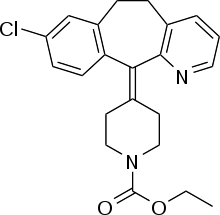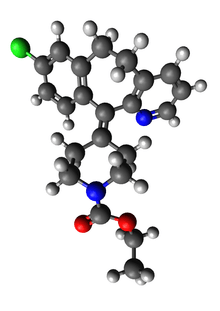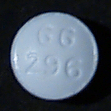Loratadine
Loratadine, sold under the brand name Claritin among others, is a medication used to treat allergies.[3] This includes allergic rhinitis (hay fever) and hives.[3] It is also available in combination with pseudoephedrine, a decongestant, known as loratadine/pseudoephedrine.[3] It is taken by mouth.[3]
 | |
 | |
| Clinical data | |
|---|---|
| Trade names | Claritin, Claratyne, Clarityn, others |
| AHFS/Drugs.com | Monograph |
| MedlinePlus | a697038 |
| License data |
|
| Pregnancy category | |
| Routes of administration | By mouth |
| Drug class | Second-generation antihistamine |
| ATC code | |
| Legal status | |
| Legal status | |
| Pharmacokinetic data | |
| Bioavailability | almost 100% |
| Protein binding | 97–99% |
| Metabolism | liver (CYP2D6- and 3A4-mediated) |
| Elimination half-life | 8 hours, active metabolite desloratadine 27 hours |
| Excretion | 40% as conjugated metabolites into urine Similar amount into the feces |
| Identifiers | |
| |
| CAS Number | |
| PubChem CID | |
| IUPHAR/BPS | |
| DrugBank | |
| ChemSpider | |
| UNII | |
| KEGG | |
| ChEMBL | |
| CompTox Dashboard (EPA) | |
| ECHA InfoCard | 100.120.122 |
| Chemical and physical data | |
| Formula | C22H23ClN2O2 |
| Molar mass | 382.89 g·mol−1 |
| 3D model (JSmol) | |
| |
| |
| | |
Common side effects include sleepiness, dry mouth, and headache.[3] Serious side effects are rare and include allergic reactions, seizures, and liver problems.[4] Use during pregnancy appears to be safe but has not been well studied.[5] It is not recommended in children less than two years old.[4] It is in the second-generation antihistamine family of medication.[3]
Loratadine was patented in 1980 and came to market in 1988.[6] It is on the World Health Organization's List of Essential Medicines.[7] Loratadine is available as a generic medication.[3] The wholesale cost in the developing world is about US$0.01 to 0.06 per dose as of 2015.[8] In the United States, it is available over the counter.[3] In 2017, it was the 59th most commonly prescribed medication in the United States, with more than twelve million prescriptions.[9][10]
Medical uses
Loratadine is indicated for the symptomatic relief of allergy such as hay fever (allergic rhinitis), urticaria (hives), chronic idiopathic urticaria,[11] and other skin allergies.[12] For allergic rhinitis, loratadine is indicated for both nasal and eye symptoms - sneezing, runny nose, and itchy or burning eyes.[13]
Similarly to cetirizine, loratadine attenuates the itching associated with Kimura's disease.[14]
Forms

The drug is available in many different forms, including tablets, oral suspension, and syrup,[12] and in combination with pseudoephedrine.[15] Also available are quick-dissolving tablets, which are marketed as being faster to get into one's circulatory system, but require special handling to avoid degrading in the package.
Contraindications
Patients with severe hepatic (liver) disorders may need to start with a lower dose. No dose adaptation is necessary for elderly or renally (kidney) impaired patients.[12][16]
Loratadine is usually compatible with breastfeeding (classified category L-2 - probably compatible, by the American Academy of Pediatrics).[17] In the U.S., it is classified as category B in pregnancy, meaning animal reproduction studies have failed to demonstrate a risk to the fetus, but no adequate and well-controlled studies in pregnant women have been conducted.[18]
Adverse effects
As a "non-sedating" antihistamine, loratadine causes less (but still significant, in some cases) sedation and psychomotor retardation than the older antihistamines because it penetrates the blood/brain barrier to a smaller extent.[19]
Other possible side effects include headache and antimuscarinic effects such as urinary retention, dry mouth, blurred vision, and gastrointestinal problems.[12][16]
Interactions
Substances that act as inhibitors of the CYP3A4 enzyme such as ketoconazole, erythromycin, cimetidine, and furanocoumarin derivatives (found in grapefruit) lead to increased plasma levels of loratadine — that is, more of the drug was present in the bloodstream than typical for a dose. This had clinically significant effects in controlled trials of 10 mg loratadine treatment [20]
Antihistamines should be discontinued 48 hours prior to skin allergy tests, since these drugs may prevent or diminish otherwise-positive reactions to dermal activity indicators.
Pharmacology
Pharmacodynamics
Loratadine is a tricyclic antihistamine, which acts as a selective inverse agonist of peripheral histamine H1 receptors.[16][21] The potency of second generation histamine antagonists is (from strongest to weakest) desloratadine (Ki 0.4 nM) > levocetirizine (Ki 3 nM) > cetirizine (Ki 6 nM) > fexofenadine (Ki 10 nM) > terfenadine > loratadine. However, the onset of action varies significantly and clinical efficacy is not always directly related to only the H1 receptor potency, as concentration of free drug at the receptor must also be considered.[22][21]
Pharmacokinetics
Loratadine is given orally, is well absorbed from the gastrointestinal tract, and has rapid first-pass hepatic metabolism; it is metabolized by isoenzymes of the cytochrome P450 system, including CYP3A4, CYP2D6, and, to a lesser extent, several others.[23][24] Loratadine is almost totally (97–99%) bound to plasma proteins. Its metabolite desloratadine, which is largely responsible for the antihistaminergic effects, binds to plasma proteins by 73–76%.[12]
Loratadine's peak effect occurs after 1–2 hours, and its biological half life is on average eight hours (range 3 to 20 hours) with desloratadine's half-life being 27 hours (range 9 to 92 hours), accounting for its long-lasting effect.[25] About 40% is excreted as conjugated metabolites into the urine, and a similar amount is excreted into the feces. Traces of unmetabolised loratadine can be found in the urine.[12]
In structure, it is closely related to tricyclic antidepressants, such as imipramine, and is distantly related to the atypical antipsychotic quetiapine.[26]
History
Schering-Plough developed loratadine as part of a quest for a potential blockbuster drug: a nonsedating antihistamine. However, by the time Schering submitted the drug to the U.S. Food and Drug Administration (FDA) for approval, the agency had already approved a competitor's nonsedating antihistamine, terfenadine (trade name Seldane), and, therefore, put loratadine on a lower priority.[27]
Loratadine was approved by the FDA in 1993.[27] The drug continued to be available only by prescription in the U.S. until it went off patent in 2002.[28] It was then subsequently approved for over-the-counter sales. Once it became an unpatented over-the-counter drug, the price dropped significantly.
Schering also developed desloratadine (Clarinex/Aerius), which is an active metabolite of loratadine.
Society and culture
Over-the-counter
In 1998, in an unprecedented action, the American insurance company Anthem petitioned the FDA to allow loratadine and two other antihistamines to be made available over the counter (OTC) while it was still under patent; the FDA granted the request, which was not binding on manufacturers.[29] In the US, Schering-Plough made loratadine available OTC in 2002.[29] As of 2015 loratadine was available in many countries OTC.[30]
Brands
As of 2017, loratadine was available under many brand names and forms worldwide, including several combination drug formulations with pseudoephedrine, paracetamol, betamethasone, ambroxol, salbutamol, phenylephrine, and dexamethasone.[31]
List of brands |
|---|
|
As of 2017 brands included: Actalor, Actidin, Aerotina, Alaspan, Alavert, Albatrina, Alerdina, Alerfast, Alergan, Alergiano, Alergiatadina, Alergin Ariston, Alergipan, Alergit, Alergitrat L, Aleric Lora, Alermuc, Alernitis, Alerpriv, Alertadin, Alertine, Aleze, Algac, Algecare, Algistop, Alledryl, Aller-Tab, Allerfre, Allerget, Allergex Non Drowsy, Allergyx, Allerhis, Allernon, Allerta, Allertyn, Allohex, Allor, Allorat, Alloris, Alor, Analor, Anhissen, Anti-Sneeze, Antial, Antil, Antimin, Ao Hui Feng, Ao Mi Xin, Ao Shu, Ardin, Atinac, Avotyne, Axcel Loratadine, Bai Wei Le, Bang Nuo, Bedix, Belodin, Benadryl, Besumin, Bi Sai Ning, Bi Yan Tong, Biliranin, Biloina, Biolorat, Bollinol, Boots Hayfever Relief, Boots Hooikoortstabletten, Boots Once-a-Day Allergy Relief, Carin, Carinose, Chang Ke, Civeran, Clara, Claratyne, Clarid, Clarihis, Clarihist, Clarilerg, Clarinese, Claritin, Claritine, Clarityne, Clarityne SP, Clarotadine, Clatatin, Clatine, Clear-Atadine, Clear-Atadine Children's, Clistin, Contral, Cronitin, Da Sheng Rui Li, Dao Min Qi, Dayhist, Debimin, Desa, Devedryl, Dexitis, Dimegan, Dimens, Dimetapp Children's ND Non-Drowsy Allergy, Doliallérgie Loratadine, Effectine, Eladin, Elo, Emilora, Encilor, Eradex, Erolin, Ezede, Fei Ge Man, Finska, Flonidan, Flonidan Control, Florgan, Folerin, Frenaler, Fristamin, Fu Lai Xi, Fucole Minlife, Genadine, Glodin, Gradine, Halodin, Helporigin, Hisplex, Histaclar, Histafax, Histalor, Horestyl, Hua Chang, Hysticlar, Igir, Immunix, Immunex, Inclarin, Inversyn, Jin Su Rui, Jing Wei, Ke Mi, Klarihist, Klinset, Klodin, Kui Yin, Lallergy, Larotin, Latoren, Laura, LD, Lei Ning, Lesidas, Liberec, Lisaler, Logadine, Logista, Lohist, Lolergi, Lolergy, Lomidine, Lomilan, Loptame, Lora, Lora-Lich, Lora-Mepha Allergie, Loracare, Loracil, Loraclear, Loradad, Loraderm, Loradin, Loradine, Lorado Pollen, Loradon, Lorafix, Lorahexal, Lorahist, Lorakids, Loralab-D, Loralerg, Loralivio, Loramax, Loramin, Loramine, Loran, Lorange, Loranil, Lorano, Loranox, Lorantis, LoraPaed, Lorastad, Lorastamin, Lorastine, Lorastyne, Lorat, Loratab, Loratadim, Loratadin, Loratadina, Loratadine, Loratadinum, Loratadyna, Loratan, Loratin, Loraton, Loratrim, Loratyne, Lorchimin, Lordamin, Lordinex, Loremex, Loremix, Lorfast, Lorid, Loridin, Lorihis, Lorimox, Lorin, Lorine, Loristal, Lorita, Loritex, Loritin, Lorly, Lormeg, Lorsedin, Lortadine, Losta, Lostop, Lotadin, Lotadine, Lotarin, Lotin, Megalorat, Mildin, Min Li Ke, Minlife, Mintapp, Mosedin, Mudantil L, Nasaler, Neoday, Niltro, Non-Drowsy Allergy Relief, Nosedin, Noseling, Novacloxab, NT-Alergi, Nufalora, Nularef, Numark Allergy, Omega, Oradin, Oradine, Oramine, Orin, Orinil, Pollentyme, Pressing, Pretin, Primorix, Profadine, Pulmosan Aller, Pylor, Rahistin, Ralinet, Ramitin, Refenax, Restamine, Rhinigine, Rihest, Rinalor, Rinconad, Rinityn, Rinolan, Riprazo, Rityne, Roletra, Rotadin, Rui Fu, Run Lai, Rupton, Sensibit, She Tai, Shi Nuo Min, Shi Tai Shu, Shu Rui, Shun Ta Xin, Silora, Sinaler, Sohotin, Soneryl, Sunadine, Symphoral, Tabcin, Tai Ming Ke, Ticevis, Tidilor, Tinnic, Tirlor, Toral, Triaminic, Tricel, Tuulix, Urtilar, Utel, Vagran, Winatin, Xanidine, Xepalodin, Xian Ning, Xin Da Yue, Xing Yuan Jia, XSM, Xue Fei, Yi Fei, Yi Shu Chang, Yibang, Zhengshu, Zhi Min, Zifar, Zoratadine, and Zylohist.[31] As of 2017, in a combination drug with pseudoephedrine, it was available under the brands: Airet, Alavert D-12, Aldisa SR, Alerfast D, Alergical LP, Alergin Plus Ariston, Alerpriv D, Alledryl-D, Allerpid, Aseptobron Descongestivo, Bai Wei Qing, Benadryl 24 D, Ciprocort D, Claridex, Claridon, Clarinase, Clarinase Repetab, Claritine Active, Claritin Allergy + Sinus, Clarityne, Clarityne D, Clarityne-D, Clear-Atadine, Coderin, Cronase, De-Cold, Decidex Plus, Decongess I, Defonase, Demazin NS, Dimegan-D, Effectine D, Ephedrol, Fedyclar, Finska-LP, Frenaler-D, Hui Fei Shun, Ke Shuai, Claritin-D, Larotin D, Lertamine, Lohist-Extra, Lora Plus, Loralerg D, Loranil-D, Loratin D, Loratin Plus, Lordinex D, Loremix D, Lorexin-D, Lorfast-D, Loridin-D, Lorinase, Minlife -P, Mosedin plus sr, Narine Repetabs, Nasaler Plus, Nularef-D, Oradin Plus, Pretin-D, Primorix-D, Rhinos SR, QiKe, Rinomex, Sinaler D, Sudamin, Sudolor, Tricel-D, Zhuang Qi, Zoman-D, and Zoratadine-P.[31] As of 2017, in a combination drug with paracetamol, it was available as Sensibit D and in combination with paracetamol and pseudoephedrine, it was available as: Atshi, Clariflu, and Trimed Flu.[31] As of 2017, in a combination drug with betamethasone, it was available as Celestamincort, Celestamine NF, Celestamine NS, Celestamine* L, Ciprocort L, Claricort, Clarityne cort, Corticas L, Cortistamin-L, Histafax Compuesto, Histamino Corteroid L, Labsalerg-B, Lisaler Beta, and Sinaler B, and in combination with betamethadol with available as Nularef Cort.[31] As of 2017, in a combination drug with ambroxol, it was available as Aliviatos, Ambroclar, Antitusivo L Labsa, Bronar, Broncovital, Broquixol, Clarixol, Ideobron, Lorabrox, Lorfast-AM, Sensibit XP, and Toraxan, and in a combination drug with ambroxol and salbutamol as Sibilex.[31] As of 2017, in a combination drug with phenylephrine, it was available as Bramin-Flu, Clarityne D, Clarityne Plus, Clarityne-D, Histafax D, Brafelix, Loramine R, Loraped, Maxiclear Cold & Nasal, Maxiclear Hayfever & Sinus Relief, and Rinavent, and in combination with phenylephrine and paracetamol it was available as Sensibit D NF.[31] As of 2017, in a combination drug with dexamethasone it was available as Alerfast Forte and Frenaler Forte.[31] |
Marketing
The marketing of the Claritin brand is important in the history of direct-to-consumer advertising of drugs.[32][33]
The first television commercial for a drug was aired in the US in 1983, by Boots, and sparked controversy. The FDA responded with strong regulation requiring disclosure of side effects and other information. These rules made pharmaceutical manufacturers balk at spending money on ads that had to highlight negative aspects.[32]
In the mid-1990s, the marketing team for Claritin at Schering-Plough found a way around these rules. They created brand awareness commercials that never actually said what the drug was for, but instead showed sunny images, and the voiceover said things like "At last, a clear day is here" and "It's time for Claritin" and repeatedly told viewers to "ask your doctor" about Claritin.[32][33] The first ads succeeded in making people aware of the brand and increased prescriptions, which led Schering-Plough and others to aggressively pursue the advertising strategy.[33]
This trend, along with advice from its attorneys that it could not win a First Amendment case on the issue, led the FDA to issue new rules for TV commercials in 1997.[32] Instead of including the "brief summary" that took up a full page in magazine ads and would take too long to explain in a TV commercial, drug makers were allowed to refer viewers to print ads, 1-800 numbers, or websites, and urge people to talk to their doctor if they wanted additional information.[32][34]
Schering-Plough invested US$322 million in Claritin direct-to-consumer advertising in 1998 and 1999, far more than any other brand.[27] Overall, spending on direct-to-consumer advertising by the pharmaceutical industry rose from US$360 million in 1995 to US$1.3 billion in 1998, and by 2006, was US$5 billion.[32]
See also
- Benzocycloheptenes
- Azatadine (loratidine minus chlorine atom and ester)
References
- "Loratadine Use During Pregnancy". Drugs.com. 10 February 2020. Retrieved 10 April 2020.
- "Clarityn Allergy 10mg Tablets (P & GSL) - Patient Information Leaflet (PIL)". (emc). 30 August 2019. Retrieved 10 April 2020.
- "Loratadine". The American Society of Health-System Pharmacists. Archived from the original on 21 December 2016. Retrieved 8 December 2016.
- "Clarityn Allergy 10mg Tablets (P) - Summary of Product Characteristics (SmPC) - (eMC)". www.medicines.org.uk. 7 October 2015. Archived from the original on 20 December 2016. Retrieved 13 December 2016.
- "Loratadine Use During Pregnancy". www.drugs.com. Archived from the original on 21 December 2016. Retrieved 13 December 2016.
- Fischer J, Ganellin CR (2006). Analogue-based Drug Discovery. John Wiley & Sons. p. 549. ISBN 9783527607495.
- World Health Organization (2019). World Health Organization model list of essential medicines: 21st list 2019. Geneva: World Health Organization. hdl:10665/325771. WHO/MVP/EMP/IAU/2019.06. License: CC BY-NC-SA 3.0 IGO.
- "Loratadine". International Drug Price Indicator Guide. Retrieved 1 June 2018.
- "The Top 300 of 2020". ClinCalc. Retrieved 11 April 2020.
- "Loratadine - Drug Usage Statistics". ClinCalc. Retrieved 11 April 2020.
- Pons-Guiraud A, Nekam K, Lahovsky J, Costa A, Piacentini A (2006). "Emedastine difumarate versus loratadine in chronic idiopathic urticaria: a randomized, double-blind, controlled European multicentre clinical trial". European Journal of Dermatology. 16 (6): 649–54. PMID 17229605.
- Jasek, W, ed. (2007). Austria-Codex (in German). 1 (2007/2008 ed.). Vienna: Österreichischer Apothekerverlag. pp. 1768–71. ISBN 978-3-85200-181-4.
- "Claritin- loratadine tablet". DailyMed. 10 February 2020. Retrieved 10 April 2020.
- Ueda T, Arai S, Amoh Y, Katsuoka K (2011). "Kimura's disease treated with suplatast tosilate and loratadine". European Journal of Dermatology. 21 (6): 1020–1. doi:10.1684/ejd.2011.1539. PMID 21914581.
- Jasek, W, ed. (2007). Austria-Codex (in German). 1 (2007/2008 ed.). Vienna: Österreichischer Apothekerverlag. pp. 1731–34. ISBN 978-3-85200-181-4.
- Mutschler E, Geisslinger G, Kroemer HK, Schäfer-Korting M (2001). Arzneimittelwirkungen (in German) (8 ed.). Stuttgart: Wissenschaftliche Verlagsgesellschaft. pp. 456–461. ISBN 978-3-8047-1763-3.
- Committee on Drugs (September 2001). "Transfer of drugs and other chemicals into human milk". Pediatrics. 108 (3): 776–89. doi:10.1542/peds.108.3.776. PMID 11533352. Archived from the original on 23 October 2007. Retrieved 2 November 2007.
- See S (November 2003). "Desloratadine for allergic rhinitis". American Family Physician. 68 (10): 2015–6. PMID 14655812. Archived from the original on July 24, 2005.
- Monson K. "Claritin and Alcohol". emedtv.com. Archived from the original on 2012-04-24.
- Kosoglou T, Salfi M, Lim JM, Batra VK, Cayen MN, Affrime MB (December 2000). "Evaluation of the pharmacokinetics and electrocardiographic pharmacodynamics of loratadine with concomitant administration of ketoconazole or cimetidine". British Journal of Clinical Pharmacology. 50 (6): 581–9. doi:10.1046/j.1365-2125.2000.00290.x. PMC 2015013. PMID 11136297.
- Devillier P, Roche N, Faisy C (2008). "Clinical pharmacokinetics and pharmacodynamics of desloratadine, fexofenadine and levocetirizine : a comparative review". Clinical Pharmacokinetics. 47 (4): 217–30. doi:10.2165/00003088-200847040-00001. PMID 18336052.
- Church MK, Church DS (May 2013). "Pharmacology of antihistamines". Indian Journal of Dermatology. 58 (3): 219–24. doi:10.4103/0019-5154.110832. PMC 3667286. PMID 23723474.
- Nelson WL (2002). "Antihistamines and related antiallergic and antiulcer agents". In Williams DH, Foye WO, Lemke TL (eds.). Foye's principles of medicinal chemistry. Hagerstown, MD: Lippincott Williams & Wilkins. p. 805. ISBN 978-0-683-30737-5.
- Ghosal A, Gupta S, Ramanathan R, Yuan Y, Lu X, Su AD, et al. (August 2009). "Metabolism of loratadine and further characterization of its in vitro metabolites". Drug Metabolism Letters. 3 (3): 162–70. doi:10.2174/187231209789352067. PMID 19702548.
- Affrime M, Gupta S, Banfield C, Cohen A (2002). "A pharmacokinetic profile of desloratadine in healthy adults, including elderly". Clinical Pharmacokinetics. 41 Suppl 1: 13–9. doi:10.2165/00003088-200241001-00003. PMID 12169042.
- Kay GG, Harris AG (July 1999). "Loratadine: a non-sedating antihistamine. Review of its effects on cognition, psychomotor performance, mood and sedation". Clinical and Experimental Allergy. 29 Suppl 3: 147–50. doi:10.1046/j.1365-2222.1999.0290s3147.x. PMID 10444229.
- Hall, Stephen S. (2001-03-11). "The Claritin Effect; Prescription for Profit". The New York Times. Archived from the original on 2015-05-27. Retrieved 2010-06-28.
- "Schering-Plough Loses Patent Lawsuit Over Claritin, Opening Door For Cheaper Generic Versions". PRNewswire. Leiner Health Products. 2003-08-05. Archived from the original on 2016-08-12. Retrieved 2016-06-26.
- Cohen JP, Paquette C, Cairns CP (January 2005). "Switching prescription drugs to over the counter". BMJ. 330 (7481): 39–41. doi:10.1136/bmj.330.7481.39. PMC 539854. PMID 15626806.
- Association of the European Self-Medication Industry Database. Loratadine OTC regulation Archived 2015-12-08 at the Wayback Machine Page accessed April 11, 2015
- "Loratadine International Brands". Drugs.com. Archived from the original on 4 March 2016. Retrieved 19 February 2017.
- "The untold story of TV's first prescription drug ad". STAT. 2015-12-11. Retrieved 2017-10-26.
- "DTC: The first 10 years". MM&M. 2007-04-01. Retrieved 2017-10-26.
- "Ten Years Later: Direct to Consumer Drug Advertising". Retrieved 2017-10-26.